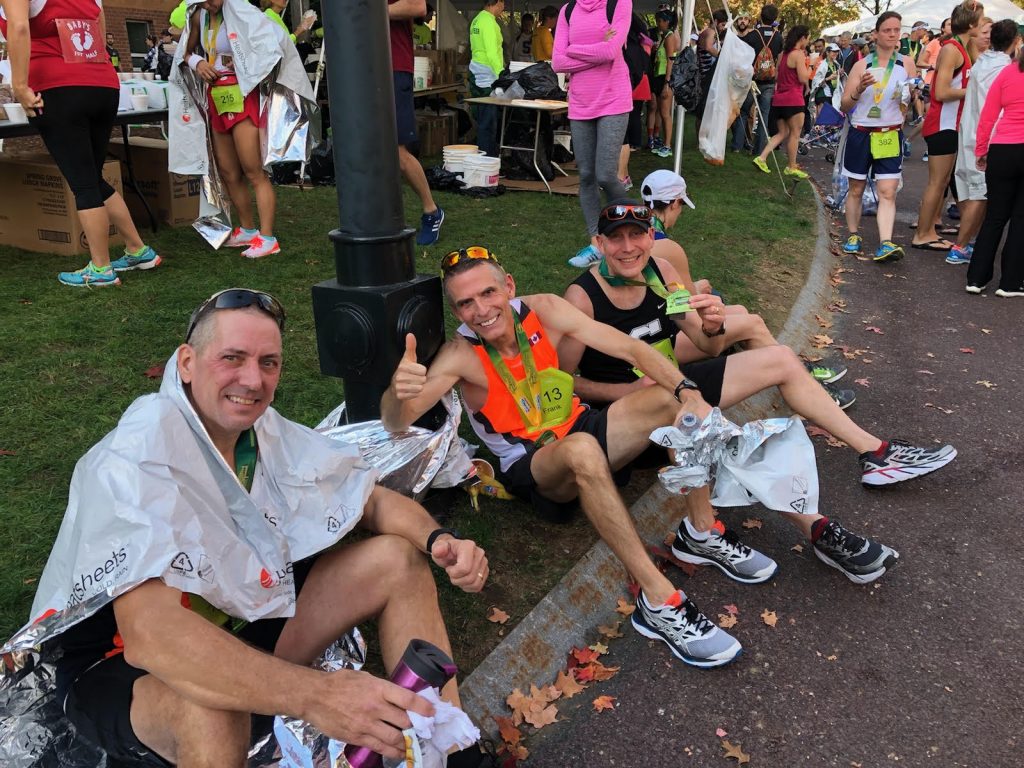Baystate Marathon 2017
Back where it all started.
 The picture is Brian, Frank and I sitting next to each other, in the finish area, on a curb. We are happy. It’s a perfect moment. Brian’s sister took the picture. It’s that rare moment just after the end of a race where you have recovered from the immediacy of the effort and the accomplishment begins to take root. You’ve got nowhere else to be. Nothing else to do. For this brief moment you take the time to relax and celebrate. You are among friends. Sure in your accomplishments. Glowing in your success.
The picture is Brian, Frank and I sitting next to each other, in the finish area, on a curb. We are happy. It’s a perfect moment. Brian’s sister took the picture. It’s that rare moment just after the end of a race where you have recovered from the immediacy of the effort and the accomplishment begins to take root. You’ve got nowhere else to be. Nothing else to do. For this brief moment you take the time to relax and celebrate. You are among friends. Sure in your accomplishments. Glowing in your success.
It is the moment where the race ceases to be a personal struggle and melts back together into a shared experience. It goes from this thing you just did to the thing we all did, each in our own way. Separate in our experience, together on the greater journey.
….
In the corral at the start I couldn’t find Frank or Brian. I wasn’t worried, but I would have been more comfortable knowing my comrades were with me. I lined up next to the 3:35 pacer. I stood on my toes and looked around but could not see them in the crowd.
It was clear and cool. Windless. A good day for racing. Weather reports said it was going to end up 70 degrees and sunny, but with the early start we should be in before that happened. The best thing, the wonderful thing was that it was dry. None of that humidity that had dogged our training runs all summer. It was like having a hot wet blanket lifted from our shoulders.
It was a good crowd. There were about 1500 marathoners on one side of the road and another crowd of half marathoners on the other. Lined up outside the Tsongas Arena in downtown Lowell. That nervous moment of anthems and oaths.
I hadn’t raced Baystate for over a decade. I thought the change in the qualification window might have had a negative impact on the attendance. Being an October race, it no longer is a qualifier for the current year’s marathon like it used to be. The cadence is broken. This race would be for the 2019 hopefuls trying to qualify 18 months in advance.
The race starts in downtown Lowell Massachusetts. The city of my birth. A gritty industrial city of brick mills built along the banks of the Merrimac River. A city of canals. A city home to successive waves of immigrants looking for a better life over the last 150 years. We, not immigrants, but transient migrants waited in the cool morning air nervous and seeking ourselves.
…
You might think after all these years of training and racing I would not be afraid. What do I have to prove?
I have lost count of the marathons I have run and raced. Since I started racing marathons in the late 90’s when I was in my mid-thirties, depending on how you count them, this marathon would be somewhere around number 60. It’s not like I have anything to prove, even to myself, but there is always something there in the back of my mind that drives me.
The training brings structure and wellness to my life. The goal gives the training a reason.
I don’t lose sleep over races. But I am afraid of racing. In a different way. I’m afraid of what it says about me and my ability and the mythos of ability, that great sandcastle of self-indulgence, hubris and pride. After all these years, after 19 trips to Hopkinton I still feel like a pretender. I don’t feel like I belong. I’m just waiting for someone to find out. Each performance is an opportunity to prove that inner critic right.
I’m afraid of trying and failing. I’m afraid of getting there late in the race, meeting the beast and giving up. I’m afraid that somewhere inside of me lives a quitter, a coward, a man meek and afraid of giving his best and coming up short. I’m afraid of not being good enough.
I didn’t have a lot riding on this race. This year is my 20th Boston. I had no driving need to qualify for number 21. But I would like to know that I can still race. I can still do the long hard training to get myself ready. I can still execute a smart marathon, end-to-end, using that training the way it should be used. I’m still invested in my ability to qualify.
Sometimes I self-destruct. Because, if you don’t really try, you can’t really fail. But if you don’t try you have already failed. As the Bard said; “A coward dies a thousand times before his death, but the valiant taste of death but once. It seems to me most strange that men should fear, seeing that death, a necessary end, will come when it will come.”
….
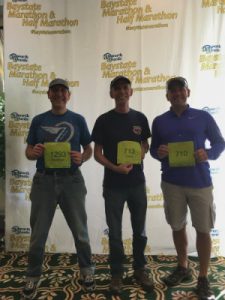 I met Frank through his brother Gordon. Gordon was and is in my running club. Frank and I both came to the marathon in our 30’s. I had been a runner of a sort in school wheras Frank started running late in life. A high school teacher. A principle. A career guy in the system.
I met Frank through his brother Gordon. Gordon was and is in my running club. Frank and I both came to the marathon in our 30’s. I had been a runner of a sort in school wheras Frank started running late in life. A high school teacher. A principle. A career guy in the system.
I remember one of the first times we ran together back in the 90’s. It was an impromptu 20 miler some Sunday morning in March. Somehow, I got copied on an email because I was one of the usual suspects. A group met at guy’s house. We ran the Boston course out from the city. I was late. I was always late. But Frank and I enjoyed each other’s company. In that weird runner’s codependence way.
In the early years of running and training for the Boston Marathon you appreciate co-dependents where you can find them. There’s a natural cadence that requires lots of long runs on frosty winter mornings. Company and codependence are comforting. Not as comforting as the warm bed you climb out of, but at least with a merry band of comrades you’re not alone on the island of your running madness.
That’s the thing about running. You train with friends. But in a race, you are alone. I don’t mean alone in the sense of physical proximity. I mean alone in the sense that the race you run is yours. The effort is yours. The execution is yours. The competition is you.
Frank is about my height but preternaturally lean. That’s why we call him ‘Bones’. Maybe 120 pounds soaking wet. I think he was amused that I was running and racing at a chubby 200 pounds in those days.
For some reason he didn’t mind and seemed entertained by my constant patois on the long runs. My theories. My stories. My jokes. We had the shared respect of the work. Of showing up and training and racing. In the shared and constant striving for the starting line in Hopkinton and the finish line on Boylston Street.
Over the years we dropped into the same racing cadence. Always aimed at Boston. Long, cold, winter runs to burn in that endurance conditioning. Long cold, winter races to tune the muscle and sinew and bones.
That was the cadence. We’d qualify in the fall and race in the spring. The runner’s conversation.
“Are you running Boston?”
“Yeah, are you running Derry?”
“Are you running Stu’s?”
“Are you running Eastern States?”
“Can I get a ride to the start with you?”
“What time do we meet?”
“Are you guys racing New Bedford?”
…
I never beat Frank.
The closest I came was one year at the infamously challenging Derry 16 miler. It was January. I was still in shape from a December ½ marathon goal and they were just spinning up their training for Boston. I was strong in the hills and had a jump on them the whole way.
He passed me on that last downhill into the finish. I was heads-down running hard. The road sand crunching under my big feet. He pulled up beside me like he was fresh as a daisy. Said ‘hi’ and left me in the dust of my effort. Another day at the office. In those days I used to run in an over-sized yellow sweater. You knew it was me from a distance. I’m sure he had been tracking me for miles.
We ran at least a dozen Derry’s. Another Dozen Eastern States 20 milers. A handful of Stu’s 30K’s. Frank and Brian and I would start, but usually I’d have to let them go towards the end.
I remember one Eastern States where we were running hard at the end as a group. They paused to hit the water stop around 18 miles in and I skipped it and ran ahead. But they caught me. Blowing past me a mile later at full on race pace.
…
When the race started I still hadn’t found my friends. I ran within sight of the 3:35 pacer. Just a bit out in front of him and his large pack of followers. I needed to pace well and was thankful to have a ready pacer.
This is a qualifying race for many. BayState boasts more BQ’s than any other race by percentage. I’m given to understand, as ludicrous as it seems to me, that people fly in and stay over to race BayState with the hope of qualifying.
I struck up a conversation, like I do, with Matt, the pacer. The pace groups have adapted to the reality of Boston. Hopefuls who need a 3:40 now pace to 3:35 to cover the 3-minute gap between qualifying and getting to run. You can’t just run the standard. You have to beat the standard to be sure that all your training isn’t for naught.
Matt, the pacer, had 20 – 30 hangers on in the early miles. They were all tucked in behind him like a great herd of hopefuls. I tend to run ahead of the pack instead of in it. There was no wind and no need for the cover of the pack.
I stayed up front chatting with Matt. Mat told me he was pacing half way and then handing off the responsibility. Someone else would pace the second half in his stead. That seemed like a good plan.
I turned around and asked the crowd how many were trying to qualify today. Almost all the hands went up. I asked how many were first time marathoners? Another dozen hands went up. They were a serious group. I couldn’t get much interaction out of them. I almost face planted tripping over a road cone when I was turned to talk to them and they thought that was funny.
Mostly they were all business. I tried to tell them that the race doesn’t start until much later, but they were all business. I pulled out ahead and ran my race. Checking over my shoulder every once in a while, to make sure I wasn’t outrunning the pacer by too much.
…
I started running with Brian in the late 90’s. He was a stocky guy for a runner. A solid guy. An ex cyclist. I had the jump on him at first because of my conditioning. Those early 20 milers I would leave him in the late miles. But, he was strong, and he got fast. A lot faster than me. Once he started training he was dipping into 6-minute miles and finding the podium at local races. He found Boston. He found Frank. And we ran.
Brian was an engineer. He left his corporate job and started his own construction business. When we ran I would do 85% of the talking. I imagine for him it was like having the TV on. Random talking in the background. That’s why we called him ‘the Silent Assassin’. You wouldn’t even know he was there… until he passed you and it was too late to do anything about it.
It was such a comfortable thing. Three guys with families and wives. Three guys meeting in the deep of a winter morning to spend 2 or 3 hours together. Three guys sharing long cold runs with the unifying force of another Boston Marathon on the horizon.
It’s hard to explain. If you asked us we would know surprisingly little about each other. But we were brothers. Brothers in the shared suffering of the Boston Marathon. The bond of running cuts deep. It’s hard to explain.
…
Somewhere in the early miles the two Hammer Gels I had brought with me jumped out of the pocket of my shorts and disappeared into the crowd of the 3:35 pace group behind me. It would have been a very poor decision to stop and try to retrieve them. I smiled and said out load “Well, I guess I’ll be living off the land now!” I still had my Enduralytes and my water bottle. I knew the course was well supported and they had Gu on the course at 7 and 17.
I’d be fine.
I struck up a conversation with two runners pacing the pack with me. I could tell from the way he ran he was a triathlete. He was a coach pacing his athlete, a young woman to her BQ try. They were willing to talk so I regaled them from my repertoire.
I also ran for a while with a 70 year old man who had run 28 Boston Marathons. We had a good chat about the old times. But, I never saw Brian or Frank.
Through the short rolling hill section in North Chelmsford at mile 5 I put a little too much distance between myself and the pace pack. Like a good student I slowed down and let them catch up. If you look at my data you can see the one slower mile in there.
Through the early miles I churned away. My heart rate stabilized into a high zone 1, low zone 2 This means, such is my aerobic engine right now that I was racing a marathon at around 120 bpm. I wasn’t watching my pace, or time or heart rate very closely but I knew the relative ease at which I was pacing boded well for a strong finish.
…
At some point Frank and Brian made the decision to go deep. My life balance wouldn’t allow me to follow. They got faster. They went sub-3 at Boston. I hung around and ran races with them and the occasional training run but they were out of my league. We ran different roads but always met in the club hotel room at the end of each year’s Boston Marathon.
As we all moved into our 50’s things began to change. The last 5 years for us were the reckoning. Breaching the 50-year-old mark was an inflection point. Life and the nature of being human beat us all down. I guess you could say we earned a break, but whether we earned it or not life gave it to us.
Frank’s hip started to ache. He fought it all the way down. Grudgingly he stopped running. He found a doctor that would resurface the a-symmetrical offending bone. For 2 or 3 years he fought to get back to what he loved.
Brian’s Mom died and the foot pain he’d been battling wouldn’t go away. He just stopped running. He just stopped. He disappeared from our long runs and only showed up at Boston to volunteer.
Plantar fasciitis knocked me out and then my heart decided that a marathon a month wasn’t a great idea. It was a long slow burning descent into the madness of maybe never running again.
But, once Boston is in your blood it’s hard to stay on the sidelines.
…
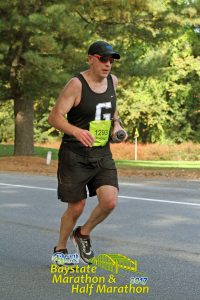 As we approached the 7 mile water stop I was pretty sure they had gels. This was the water stop my club had run for years. This year, sadly, the race organization didn’t need our services. Many the October morning I spent at that water stop cheering on my friends and handing out necessaries.
As we approached the 7 mile water stop I was pretty sure they had gels. This was the water stop my club had run for years. This year, sadly, the race organization didn’t need our services. Many the October morning I spent at that water stop cheering on my friends and handing out necessaries.
Sure enough they had Gu. I took a chocolate espresso gel. I didn’t eat it just yet, but I felt better that I had some fuel. I drank a bottle of UCann before the start that had fueled me through the early miles. I could probably survive on the odd quaff of Gatorade but I was in it for the long term and needed to play it safe and plan ahead.
Once we got over the bridge in Tyngsboro I took the gel and washed it down with water. My stomach was good. I was refilling my water bottle as necessary. I was sweating but not a lot. I was staying within myself and the effort level was reasonable.
The only issue I had was the mistake of eating too much, too late for dinner the night before. There’s that self-sabotage again. That pasta started weighing heavily on my belly. I started looking for a porta john. It wasn’t urgent, but I knew it could turn into a ‘code brown’ if I didn’t attend to it. Better to stop on my terms if I got a chance.
I ran the tangents down the back side of the river loop. Running smart and staying just ahead of the pace pack. Since it was a two-loop course we could see the high mile markers on the road. The markers were about 100 feet apart. Just after what was 11 and what would be 21 we turned back over the Rourke bridge. I accelerated a little because I remembered where the next porta john was.
My thought was to let out the leash a little, build a gap, jump in, do my business and pop back out to catch the pace group. The porta john was around mile 14. I ran behind the water table on a bee-line for it. Wouldn’t you know it, some other guy beat me to it. But I was committed now. Luckily, he was brief and I was too. Still I might have lost 2 minutes in the process.
I got back on course and started to hunt.
…
I had totally blown my taper and pacing execution at my target race 3 weeks earlier. I had gone out too fast, knew I was doing it and did it anyway. Such is my psychosis. But from the wreckage of that race I took away an understanding that my fitness level was quite good. If I could spread the effort, if I could get my legs to hang in there, if I got the right race conditions, I had no doubt there was a faster marathon in me.
I managed to walk away from that race without trashing my legs. I wasn’t smart enough to pace well in the beginning, but I was smart enough to back off at the end and save my legs. I was already thinking ahead.
I knew Frank and Brian who I had been training with all summer had set BayState as their A race. I knew they were targeting a pace that was close to the pace I was targeting. If I could hook up with them early in the race maybe they would hold me back and I could spread out my effort intelligently and meet my goal.
It didn’t take me long to make the decision, to double down, to sign up for BayState and refocus.
…
Coming out of the rest stop I knew I had some ground to make up to catch the pace group. But I felt good and eased into a faster pace. In the data you can see the one mile at 8:45 where I took the stop. But that’s not a straight forward equation. That 8:45 contained the 7-something I put in to build a gap and the 7 something I ran coming out. The next two miles clock in around 7:40 as I worked to catch the pack.
It felt good to be letting the dogs off the leash a little. This was the section with the slight hills. After I popped out of my poop break I began working my way up the course picking off runners ahead of me. I came up on a familiar form. It was Dave McGilivary the race director of the Boston Marathon, running alone in his MR8 singlet.
As I pulled up and passed I said; “Hey Dave, it’s me Chris Russell.” To which he grunted a response. He was working hard and not in a mood to communicate so I pushed on.
Around the next corner and up the long hill I saw another familiar form. It was Brian! As I pulled up behind him on the hill I yelled “Brian! It’s me Maddog!” and he grunted in response. Geeze, no one wanted to talk to me. Everyone was strictly business. I squinted up ahead and saw a knot of runners about ¼ mile on.
I asked Brian, “Is that the 3:35 pace group?”
He said, “I think so.”
I put my head down and went back to hunting. Within a mile and a half I pulled up behind the stragglers trailing off the back of the pace group. I said ‘hi’ to the triathlete and his charge. As I neared I saw her form was starting to fall apart. I said, “Hey check your runner, she’s losing her form.”
I pulled up to the new pacer, Nat, and said to the pack; “You folks miss me?”
Someone said, “Yeah, where’d you go?”
“I had to poop! Everybody poops.”
…
Frank was anxious when we met at the expo on Saturday. He’d been training hard getting back to where he could take a run at a qualifier after having his hip resurfaced a couple years back. He had issues in his last long run at the end of the build cycle. The muscles in the joint had failed him and he had to walk.
He had 90% decided not to race. Me being the voice of un-reason talked him back into it.
I argued that it was the end of a hard cycle and a peak week. That was the worst it would get. Coming out of the taper everything will get much better.
Start slow and if it feels ok in the high miles race, if it doesn’t you can bail. He was afraid of having to post his first DNF. Pride. I told him it was different now. We weren’t trying to pound out a 3-hour marathon. We were just going to pace it to a 3:40. It’s an entirely different race.
He committed to give it a try. But, I could tell he was worried.
…
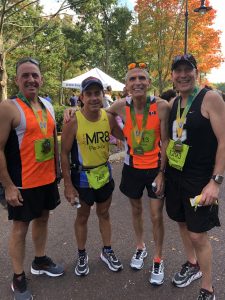 BayState and I have a history. Baystate has a history with all of us.
BayState and I have a history. Baystate has a history with all of us.
The course is 10 miles from my house in Lowell Massachusetts. It was created as a race for the local club runners to qualify for Boston at. Let me repeat that. The course was specifically designed by local runners who qualified for Boston every year to be a Boston qualifier.
The course has changed a bit over the years but the meat of it is the same for the would-be marathon qualifiers. It’s a two-loop course that hugs the Merrimack River. Because it runs along the river it is flat. Not pancake-flat, but as flat as you can get in Massachusetts outside of a track. There might be 250 feet of gain on the whole course.
Baystate was my second marathon, ever, and my first qualifier. Back in 1997 I ran scared to a 3:09 finish after a summer of speedwork. Ironically that time would still qualify me at 35 years old, but probably wouldn’t be fast enough to get me into the race.
That was the old course. The new course is similar but starts and finishes in the city proper. I have qualified on the old course twice. I have DNF’ed on the old course too. I have raced the new course once before in the tail end of a hurricane with 30 mph wind gusts and couldn’t close the deal that day.
Frank currently lives less than a mile from the course. We routinely run our long runs on parts of the course. The Mill Cities Relay, our annual end of season relay race celebration for all the local running clubs runs down the back side of the river. On the same course. I’ve probably run the course in one form or another 100 times over the years.
Yeah, the BayState marathon for me is like that old, worn coat that you love put on in the fall.
…
After catching the pack on the back side of the course around mile 16 I fell in with them and let my effort settle a little. The big pack of 25-30 had whittled itself down to 10-12 and they were streaming off new pacer Nat’s shoulder like dust from a fading comet.
I knew the gels were coming up at 17 and grabbed another one. Right after that 17-mile water stop you cross the Tyngsboro bridge again and begin to head back to the city. This is the home stretch. It is psychologically downhill from here.
I sucked down that second gel on the other side of the bridge and began to prepare myself for the looming contest. I did not know what to expect. After mile 18 the end can come suddenly. But I had paced well and knew I was at least 6 minutes up on my qualifying time. All I had to do was execute. No heroics. Just keep pacing and work the tangents.
Brian’s sister and his kids kept popping up on the course every so often and cheering me and my Goon Squad singlet on. That made me smile. There’s not much crowd support on the course so seeing a familiar face was welcome.
…
One of the other great things about this course is that it is chock full of milestones. You have the bridges. Then on the back stretch you have the old horse farm, the golf course, the tech school and then the boat house. All familiar milestones for me as the miles progress.
This time as we ran past 21 instead of turning over the bridge we kept going straight down the boulevard along the river towards the finish.
Somewhere around 21 Nat, the pacer pulled up and started chatting at me. I calmly apologized and informed him that I was going to another place now and would not be available for conversation. I was dropping into the race zone.
…
Systems check.
My head was clear. My legs were fine. My energy was good. It was work but it was the kind of work the high miles in a race is supposed to be.
I wasn’t soaked with sweat. The dryer weather kept the water loss manageable. I had my black Phoenix Rock and Roll hat and my sunglasses that I got from the liver foundation for Boston 2015. Now that we were headed back the sun was rising. There wasn’t any wind and there weren’t any clouds, but it wasn’t hot.
My black Goon singlet with the big white ‘G’ wasn’t sticking to me. My Brooks baggie shorts weren’t clinging. The only chaffing I would end up with would be just a smidge from my HR chest strap. No bloody nipples today. No chaffing in the crevices or on the pointy bits.
I had my bike bottle in my hand and refilled it 2 or 3 times as needed but never felt like I was forcing fluids or getting behind.
The old Hokas weren’t squishy with sweat. I made the call to wear the Hokas again. They probably have 1,000 miles in them. I bought them for Boston in the spring. This would definitely be their last race. They were starting to wear.
But I had trained in them, they were familiar and at the end of the day it’s not about the shoes.
I focused hard on racing. Pulling within myself and waiting. Mile 18, 19, 20, 21 they clicked by. I let the pace group go behind me, or more accurately, stopped worrying about the pace group and just ran my race. In the data you can see my HR start to creep up out of zone 2 into zone 3 as the blood thickens and the effort level rises.
Time to race. Pace, tangents, execution. Keep laying it down. Pull your form in tight and hold that pace. Execute.
…
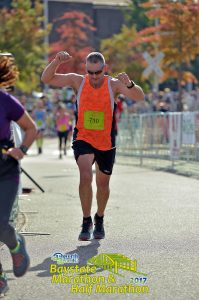 A couple minutes behind Brian could see me up ahead. He stalked the 3:35 pace group and held his pace. He wasn’t watching his watch but knew they were a couple minutes fast. He had executed his race plan, starting out slow, running steady splits and putting himself in a position to close it hard late.
A couple minutes behind Brian could see me up ahead. He stalked the 3:35 pace group and held his pace. He wasn’t watching his watch but knew they were a couple minutes fast. He had executed his race plan, starting out slow, running steady splits and putting himself in a position to close it hard late.
Kelly, his sister jumped in with him for the last few miles. She’s an accomplished marathoner and a veteran of Boston. She knew what he needed and got him to focus and work his form. He was hanging on. He was where he wanted to be.
…
A couple minutes behind Brian, Frank was feeling ok. His hip was holding up. He had started out very easy and would need to negative split the course to get his time. That was his strategy. Coming over the bridge he checked his watch and knew he had some time to make up to get into Boston.
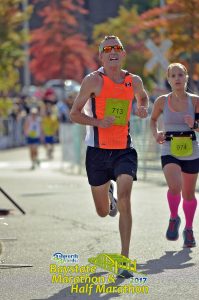 He didn’t quite know how much time he had. He knew it was close. On the back stretch he dropped the hammer and began that long 10K into the finish. He was running scared.
He didn’t quite know how much time he had. He knew it was close. On the back stretch he dropped the hammer and began that long 10K into the finish. He was running scared.
…
Somewhere around mile 22 Nat the pacer pulled up beside me. I think he was chasing me. I looked at my watch and my head was clear enough to do the math. “You know your 3 minutes up on your pace, right?” He made some “Oh Crap” noises and slowed down like someone had pulled a drag chute.
That last stretch, down the river, is part of the 10-mile leg of the Mill Cities Relay that I have raced many times. I knew there were some unnecessary short climbs in there. I thought we were going to turn over the University bridge and it would be one last 1/2mile push downhill to the finish.
I had the finish wrong. The bridge I thought we were going to cross came and went. I checked my watch and we still had a couple miles to go.
But I was running strong. I just put my head down and continued to execute. It didn’t matter where the finish was. Wherever it was that was where I was going.
And to get there I had to execute.
Focus, pace, form, tangents. My head was clear. My legs were good. I was working hard but it was the work of earned training, not the suffering of the crash.
I started passing stragglers and the occasional walking dead. I wasn’t looking at my watch. It didn’t matter. I kept running. Finally, a turn over an open-mesh metal bridge across the river. The finish had to be close.
We ran through a back lot area, the surfaced rough and pockmarked with the abuse of hundreds of years of mill workers. I recognized the old Wannalancet mill where the brewery used to be. Another hard right. Another short rough section of road.
There were people screaming encouragement. I didn’t hear them really.
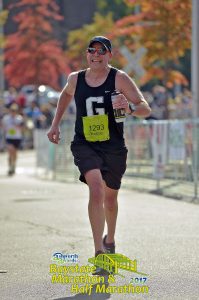 I could hear the finish. I knew where I was. There was a guy deep in the throws of a crash ahead of me weaving in the tangents. He’d run a bit then stumble a bit. I had to time it right to get by him on a corner.
I could hear the finish. I knew where I was. There was a guy deep in the throws of a crash ahead of me weaving in the tangents. He’d run a bit then stumble a bit. I had to time it right to get by him on a corner.
I snuck by and we were back on the ? road. I could see the turn into the Arena driveway a few hundred feet ahead. I stretched out my stride and gave it everything I could. I jammed hard down the driveway towards the chute. My legs were letting me push hard. I left it all on the course and staggered through the chute and across the mats.
Bent over and sucking air I was very happy and may have thrown my arms up in celebration. I forgot to stop my watch as I got some water and picked up a medal.
The clock read 3:33. 6 ½ minutes under my age group standard.
…
I walked back up the chute to the finish. Watching the runners crash through in ones and twos. In a small race like this the flow is intermittent. I shouted encouragement and high fived as they came through. Some of them I recognized from the hours out on the course.
I knew Brian was behind me. And in a moment, there he was, pushing hard, giving it everything. He pushed across the matts at 3:35. He executed on his training and ran a negative split. I gave him some water as we celebrated and traded war stories about the race.
Nat the 3:35 pacer came through with only 1 or 2 runners still with him.
…
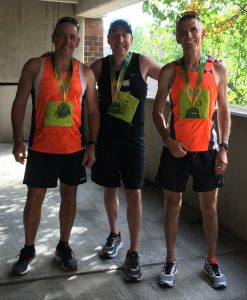 Brian and I wandered through the finish area. We met up with his family and got some food. Then Frank came bouncing up behind us. He had dug deep and finished in 3:37 laying down a handful of fast miles to beat the standard.
Brian and I wandered through the finish area. We met up with his family and got some food. Then Frank came bouncing up behind us. He had dug deep and finished in 3:37 laying down a handful of fast miles to beat the standard.
We wandered through the food line with our medals talking with exhausted excitement about the race. Like we had just spent the last few hours holding our breath and now could finally exhale with the passing of the storm and look back fondly at the tempest.
A resurfaced hip. A recovered foot. A cryo-ablated heart. A summer of hot training. 20 years of running together. It all started with this race.
Here we were back from the dead, so to speak. The perfection of that moment is in our eyes as we lowered ourselves ungracefully to sit on the low curb and mugged for that photo. Back where it all began. Three old guys. Three comrades of many battles.
With three shiny new Boston Qualifiers.
…
CHRISTOPHER RUSSELL 376 1354 48/128 8:09 3:33:33.5 BQ

